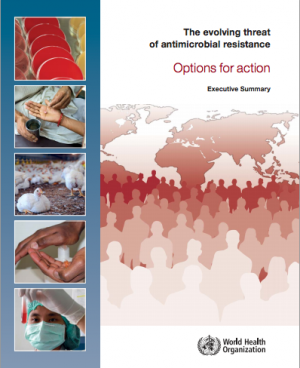Antimicrobial Resistance: Difference between revisions
No edit summary |
No edit summary |
||
| Line 6: | Line 6: | ||
== Mechanism == | == Mechanism == | ||
{{#ev:youtube|4oukHcpQoXM|300}}<ref> | |||
U.S. Food and Drug Administration. Animation of Antimicrobial Resistance. Available from: http://www.youtube.com/watch?v=4oukHcpQoXM[last accessed 21/3/2020]</ref> | |||
== Causes == | == Causes == | ||
It isn’t an isolated responsibility we can classify it into individual level, governmental or national level even global level | It isn’t an isolated responsibility we can classify it into individual level, governmental or national level even global level | ||
Revision as of 12:49, 21 March 2020
Introduction[edit | edit source]
Antimicrobial resistance (AMR) is not a recent phenomenon, but it is a critical health issue today. Over several decades, to varying degrees, bacteria causing common infections have developed resistance to each new antibiotic, and AMR has evolved to become a worldwide health threat. With a dearth of new antibiotics coming to market, the need for action to avert a developing global crisis in health care is increasingly urgent.
Definition[edit | edit source]
When microorganisms such as virus, bacteria, parasites, fungi changed in some way and become have resistance to medical drug that used to treat their infections and change it to be ineffective. AMR is a general term for many types of resistance such as antiviral, antibacterial, antiparasites and antifungal drugs.
Mechanism[edit | edit source]
Causes[edit | edit source]
It isn’t an isolated responsibility we can classify it into individual level, governmental or national level even global level
Individual level:[edit | edit source]
Illogical use of over- counters antibiotic drugs from different types for example people use it in case of viral infection, cold or flue
Some times people share their their antibiotic or drug based on their experience
Poor hygiene
National or governmental level:[edit | edit source]
low quality medicine due to lack of tools and methods of diagnosis that lead to
Wrong prescription of drugs and some doctors prescribe wide spectrum of antibiotic drugs for patient as a treatment instead of one specific
poor infection prevention and control in some organizations, hospitals and health care centers.
Spreed of drugs without control from governments
In addition to a substantial financial burden that national health-care budgets can ill afford, AMR has economic consequences far beyond the health sector, such as damaging repercussions on international travel and trade resulting from the cross-border spread of resistant infections. The cost of not acting against AMR needs to be considered when deciding resource allocation and assessing interventions.
Some of the most common bacterial infections resistant to antibiotics are:
- Methicillin-Resistant Staphylococcus Aureus (MRSA)
- Pneumonia
- Tuberculosis
- Gonorrhoea
- Blood stream infections
- Escherichia coli
Resources[edit | edit source]
The evolving threat of antimicrobial resistance - Options for action[2][1][1] describes examples of policy activities that have addressed antimicrobial resistance in different parts of the world, with the aim of raising awareness and in particular to stimulate further co-ordinated efforts.
References[edit | edit source]
- ↑ U.S. Food and Drug Administration. Animation of Antimicrobial Resistance. Available from: http://www.youtube.com/watch?v=4oukHcpQoXM[last accessed 21/3/2020]
- ↑ The evolving threat of antimicrobial resistance - Options for action. WHO. 2012







